October 23rd, 2023Improving data for aerial firefighters
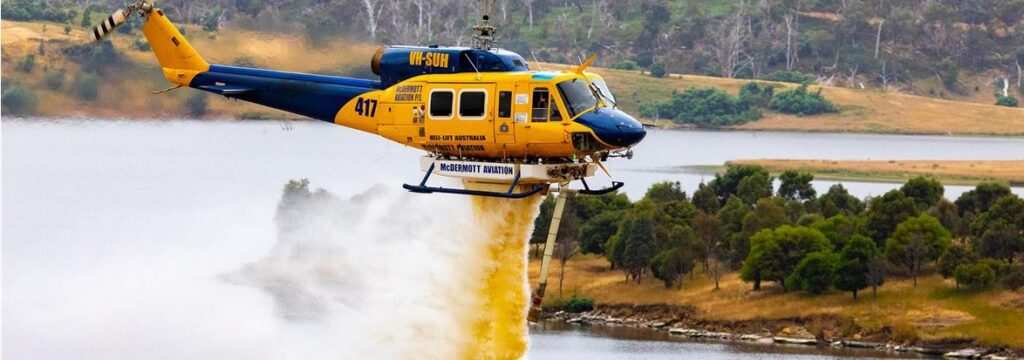
A collaborative research project is improving the data used by aerial firefighters to find nearby water sources, the CFA says.
During active bushfires, aerial firefighting units are dispatched by members of the National Aerial Firefighting Centre (NAFC). NAFC members use a variety of data sources to find suitable nearby water sources for firefighting helicopters and fixed-wing aircraft. It is critical for effective decision-making that the most current and accurate data about the location of water is available as quickly as possible.
The Identifying Water Sources For Aerial Firefighting project is a collaboration between NAFC/AFAC, Natural Hazards Research Australia, Geoscience Australia (GA) and FrontierSI that is improving the reliability and clarity of information about water bodies by adding recently observed water and currency attributes to datasets used by firefighters.
CEO of Natural Hazards Research Australia Andrew Gissing highlighted the benefit of collaborative research when advancing Australia’s bushfire planning technology.
“This project is a great example of ways we can work together to serve emergency management and the community through high-impact research,” he said. “The project team from Natural Hazards Research Australia, NAFC, GA and FrontierSI has delivered new scientific knowledge that’s actionable and useful in keeping our communities safe from bushfire.”
The first phase of this project – now complete – focused on extending an earlier proof-of-concept project developed through the Bushfire and Natural Hazards CRC. A workshop in February 2023 gathered perspectives from several key emergency management agencies across Australia about the ways they currently use waterbody datasets and how these datasets might be improved for bushfire pre-planning decisions.
Users provided insights into new information and software requirements, operational suitability and additional waterbody attributes (such as waterbody features, dataset currency, surrounding environment and biosecurity risks) that would strengthen the relevance and accuracy of existing waterbody datasets.
Following this, the project team (managed by Anthony Gallacher at NAFC) delivered a method to augment GA’s Digital Earth Australia satellite-based data products with the latest water availability information to meet NAFC’s needs.
This significantly improves the accuracy of agencies’ knowledge about nearby water and provides critical support to disaster management planning to facilitate rapid and effective bushfire response. In the past, data about nearby waterbodies might have been months or years old, but now this information is updated regularly and can be easily accessed.
The new system:
- identifies aircraft-accessible waterbodies
- contributes to aircraft selection and allocation based on access to water
- contributes to efficient use of aircraft
- provides information to air desks, air bases and air crews to help their situational awareness and decision-making.
October 22nd, 2023Firefighters contain Berringa grassfire
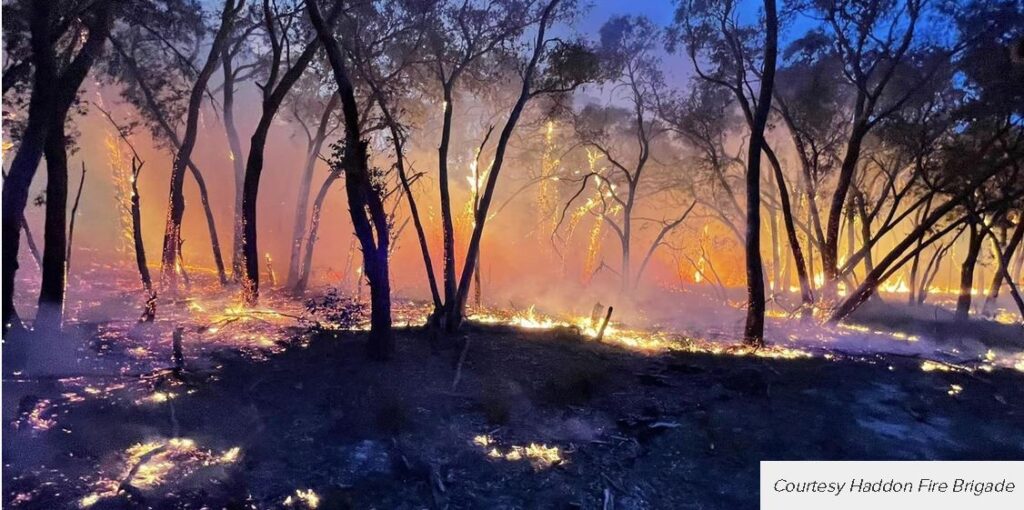
Firefighters had to work hard overnight to contain a grassfire at Berringa last week.
The CFA was called to a private burn-off out of control at 4.42pm last Wednesday (11 Oct) on Donald McLeans Road.
Strike teams and two water aircraft were called in to assist due to the spread of the fire which burnt around 40 hectares of land.
FFMVic was also brought in with dozers to establish a containment line.
An Advice message was issued at 5.22pm which escalated to a Watch and Act at 6.55pm for residents in Berringa and Cape Clear.
The fire was heading in a southerly direction from McLeans Road towards Derwent Jacks Road.
The fire was contained at 7.35am last Thursday (12 Oct) and the Watch and Act has been downgraded to an Advice message.
District 15 Commander Steve Poulter said crews did great work overnight to control the fire.
“Weather conditions are favourable today with rain currently over the fireground and low wind speeds expected throughout the day,” he said last Thursday.
“We’re not in fire restrictions in this area yet but a reminder to people to be mindful of weather conditions before conducting private burn-offs.”
October 9th, 2023Pioneering Nancy shares CFA wisdom
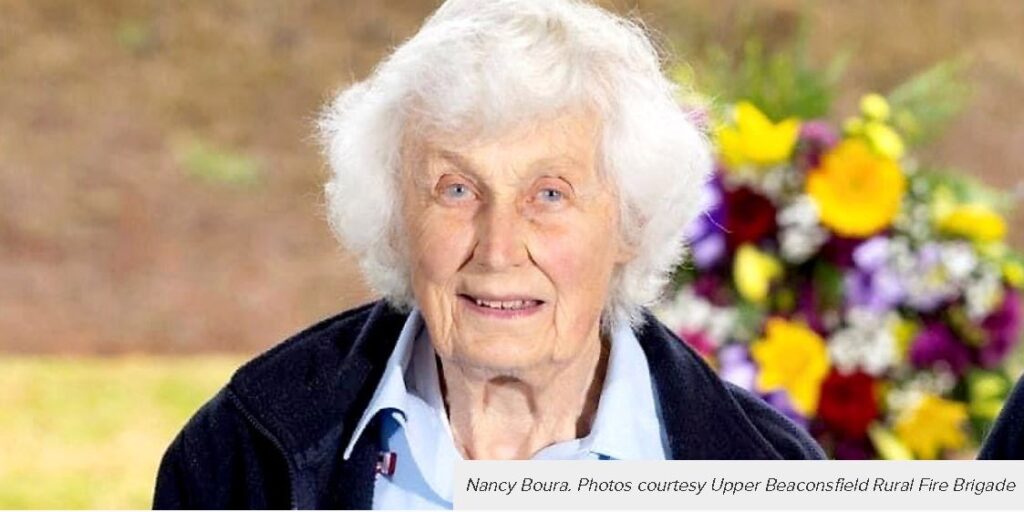
Nancy Boura is one of the early pioneers of women firefighting in CFA.
A firefighter from 1981 to the end of 2014, Nancy is believed to have attended more than 1,000 incidents during her time as an operational member, and she remains an enthusiastic member of the brigade today.
Nancy joined Upper Beaconsfield in May 1978 after seeing an ad in the local newspaper encouraging people to join the brigade’s newly-established auxiliary. At the time she thought she would be feeding firefighters, but little did she know how involved she would become.
She would soon add Communications Officer to her belt, managing the brigade’s incoming emergency calls via what was the Fire Reporting Service, and also alerting other brigades in the area when they turned out to incidents.
In the 1980s, Upper Beaconsfield, like many other small communities, found itself in the position where many of the brigade’s firefighters were forced to find work away from town. This left the brigade with a limited crew to respond to incidents during the day.
Nancy was working at an apple orchard for then brigade captain Eric Bumpstead. Eric approached Nancy and a number of other women to gauge their interest in being trained to be firefighters to help bolster the brigade’s ranks. At the time, it wasn’t widely accepted that women could be firefighters, and the group initially trained in private at Eric’s orchard until they gained confidence in their abilities.
They soon gained the necessary skills to turn out to their first fire together and they were successful in controlling and extinguishing the blaze. The women would affectionally come to be known as Eric’s Angels after the popular television show Charlie’s Angels. Nancy would go on to learn how to drive the brigade’s vehicles, successfully gaining her truck licence.
“I came to Australia from England and knew no one in the area,” Nancy said.
“Volunteering with CFA initially was a way of getting to know people. I figured I could join the auxiliary because I was capable of making sandwiches and taking them out to the fire front.
“Then it got out hand and I ended up being a radio operator and then one of the first women firefighters in Upper Beaconsfield,” she reflects, smiling.
“When you’re with a fire brigade you always have a second family, and it’s a useful way to do something for the community.”
The 1983 Ash Wednesday bushfires played a huge part in Nancy’s life and role as a CFA volunteer. On that day, Nancy was an integral part of a seven-member crew on Upper Beaconsfield’s tanker 1 which included her then 17-year-old son Jon. The crew endured a burn under in Officer and two burn overs in Mount Misery in Beaconsfield and Critchley Parker Jr Reserve in Guys Hill where they were forced to vigorously protect their own lives.
The only woman on board, she calmly reverted to her valuable training and applied the important principles that had previously been taught to her. To this day, she believes this training and principles saved their lives as fire raged around them. Fellow crews would not be so fortunate, with 12 firefighters from two other brigades losing their lives in the same fire. The town of Upper Beaconsfield was also completely destroyed.
“We heard on the radio that there was a fire to the north coming our way and decided to turn the trucks out even though the fire wasn’t on us at that point,” Nancy said.
“By the time we arrived at the station the fire was spotting down Cardinia Creek to Officer.
“From there on we just got busy. We headed down to Officer to start with and then moved back to Mount Misery and then onto Critchley Parker Jr Reserve. We were there when the wind changed.
“It was one long day of one disaster after the other. There were times when the fire caught up with us.
“It’s not something you can describe, and I am grateful for the excellent training we had had with our captain.
“That day was the start of a month or so of turning out; I was either on the truck at the fire or manning the radio base.”
As a result of Ash Wednesday Nancy realised that there was insufficient detail in the brigade’s current map books. She set about creating a detailed and accurate local map reference book which included roads and tracks, water points (including private dams), points of interest, property boundaries and accessibility points. Nancy’s Map Books, as they are affectionately known, are still widely used today and form part of the inventory on all Upper Beaconsfield’s vehicles.
Across her volunteer career Nancy has received a National Medal, National Emergency Medal and Brigade Life Membership. She was recently honoured for her remarkable contribution, receiving the Women and Firefighting Australasia (WAFA) Outstanding Contribution by a Female Firefighter Award as part of the 2023 Women and Firefighting Awards.
“Across her more than 45 years of service, Nancy has been a vital part of our brigade,” current Upper Beaconsfield Captain Ian Pinney said.
“She is still usually one of the first to put her hand up or name on a roster for a fundraiser barbecue and has been instrumental in raising funds for the upgrade of operational equipment and vehicles.
“She can also often be found at the station cleaning up, vacuuming, cutting up rags, setting up chairs in preparation for meetings, washing dishes, getting barbecue supplies ready or weeding the station garden beds.
“She may be quietly spoken but when Nancy talks you listen because it is more often than not a very wise head with many years of practical experience talking.”
October 8th, 2023Guildford firey Will ‘always happy to help’
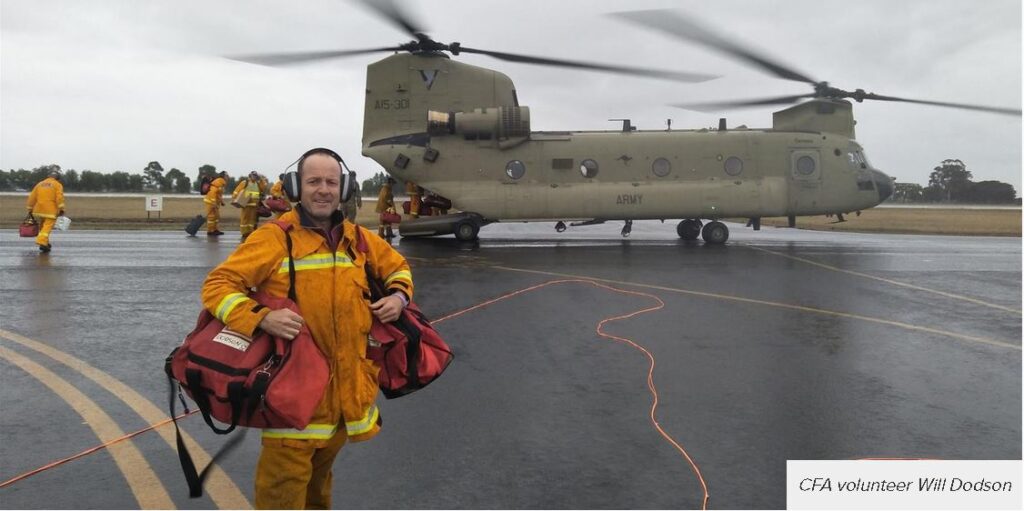
A CFA volunteer since the age of 14, Guildford Fire Brigade Firefighter Will Dodson is always happy to help.
“I’m proud to be a CFA volunteer and wherever I am in the world I feel like I should help people,” Will said.
Will recently travelled around Ireland on holiday. While he was between Dublin and Cork he saw a plume of black smoke on the horizon and immediately knew it was a car accident.
“As we approached the accident, I saw a car engulfed in flames and an elderly man standing next to it. I pulled up to help him.
“The man looked like he was in shock and was standing quite close to the burning car. He said he’d lost his wallet and phone in the fire. He really needed some help and I was happy to give the man my time.
“I shouted to him to come over to me to move him to safety and I gave him water. Shortly after, the car exploded.
“A young man stopped to see if he could also help. I asked him if he could give the man a lift to the nearest town.”
Until recently, Will was the community safety coordinator for Guildford brigade and found the role very rewarding.
“I was the community safety coordinator for six to seven years and enjoyed engaging with the community,” Will said. “I liked building relationships and making a real difference in the community helping to organise fuel reduction burns and home inspections.”
Will is also a firefighter and will soon be carrying out pre-season training including a burnover drill, draughting and skills maintenance.
“The last couple of fire seasons have been quiet and brigade motivation can drop off. But we are gearing up for a much busier season this summer.”
October 6th, 2023Burn-off escapes control
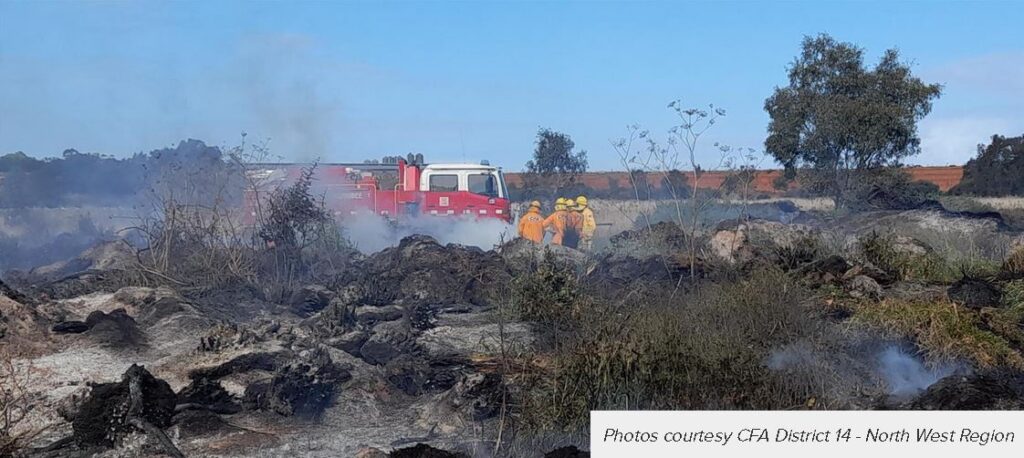
CFA firefighters were quick to control a private burn-off that escaped at Werribee South last week.
CFA responded to an out-of-control burn-off on K Road at about 1.30pm last Wednesday.
When crews arrived they found a grass fire that had spread to around six hectares in size, and multiple piles of green waste had caught alight.
CFA was also supported by Victoria Police, Ambulance Victoria, Fire Recue Victoria and FFMVic.
The fire was brought under control at 2.12pm but crews remained on scene for some time blacking out.
CFA had nine vehicles on scene.
October 5th, 2023Brigades that train together…
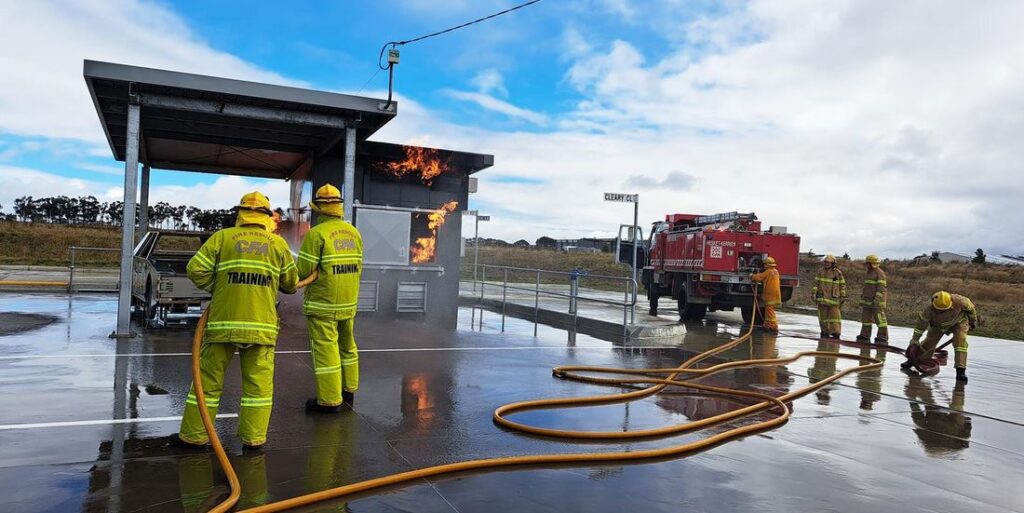
Located in the Macedon ranges, Hesket-Kerrie and Newham brigades know that planning and training together is important because emergencies don’t respect brigade boundaries.
Looking after an area with a mixture of farms and bush properties, with parts of the Cobaw State Forest to the north, Macedon State Forest to the south and Hanging Rock in between, these two small brigades respond together to incidents in each other’s communities, surrounding brigades’ areas, as well as joining forces to form strike teams and composite crews for fire and other emergencies.
The brigades know that getting to know each other’s skills and resources ensures a collaborative effort that enhances capabilities and response to incidents.
Hesket-Kerrie and Newham work together in several ways including fundraising, supporting events at Hanging Rock, and community days at each other’s stations. They realise a connected community is a more resilient one.
The two brigades have also shared resources including crews and vehicles. For example, when Hesket-Kerrie’s tanker 2 was out of commission during the 2022-23 fire season, Newham lent its tanker 1 to Hesket Kerrie’s Cherokee satellite station. Joint knowledge meant brigade members understood the significance of having a truck in this extreme risk area, and that Hesket-Kerrie would support response into Newham from the Hesket station.
Hesket-Kerrie is now fundraising for a new medium tanker.
“It’s not about empire building, it’s about community risk and knowing how best to cover each other’s backs,” Newham Fire Brigade Captain Bryan Hornbuckle said.
Each brigade brings unique experiences and lessons learned. Sharing these experiences through joint training sessions helps identify best practice, areas for improvement, and fosters camaraderie. Training has included mobile props, scenario drills, burns-offs and members sharing knowledge such as air support expertise.
The brigades’ two training officers recently organised a joint training day at VEMTC Central Highlands. Hesket-Kerrie and Newham were the first brigades from District 2 to use this new training ground. Members ran through a motor vehicle accident and structure and smoke house props and drills, which provided an excellent insight into what members can expect.
October 3rd, 2023Unattended burn off sparks Spring Hill blaze, prompts warning
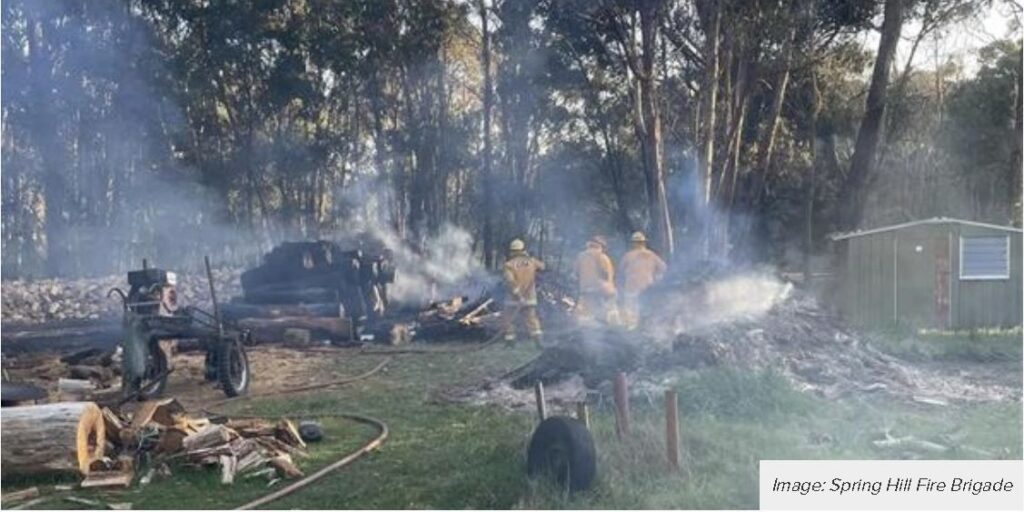
With the weather warming up over recent days, the CFA has already been called to a number of fires across the state, including an unattended burn off in Spring Hill – between Glenlyon and Woodend.
High winds caused embers to spread to a nearby pile of logs, causing a large amount of firewood and some processing equipment to be destroyed, the CFA reported following the incident late last month.
Spring Hill Fire Brigade 2nd Lieutenant Andrew Jan said Trentham brigade crews made an initial attack, extinguishing the fire on the machinery.
“When we arrived on scene, we saw what appeared to be an unattended burn pile. There were heavy winds blowing embers toward a large pile of logs roughly 20 metres away that had become well alight,” Andrew said.
“The fire had started moving through some fine fuels on the ground to a large pile of firewood, so the initial role of the crew was to contain that.
“By using Trentham’s Big Fill, we were able to attack the fire in a more effective manner and release tankers quickly, cutting down the time needed to fight the fire.”
The scene was declared under control around 15 minutes after the first vehicle arrived on scene.
The incident has prompted the CFA to urge landholders to always register their burn offs, to never leave burn offs unattended and t always ensure burn offs are fully extinguished, especially ahead of warm, windy days.
October 3rd, 2023Wye River brigade’s water tank initiative
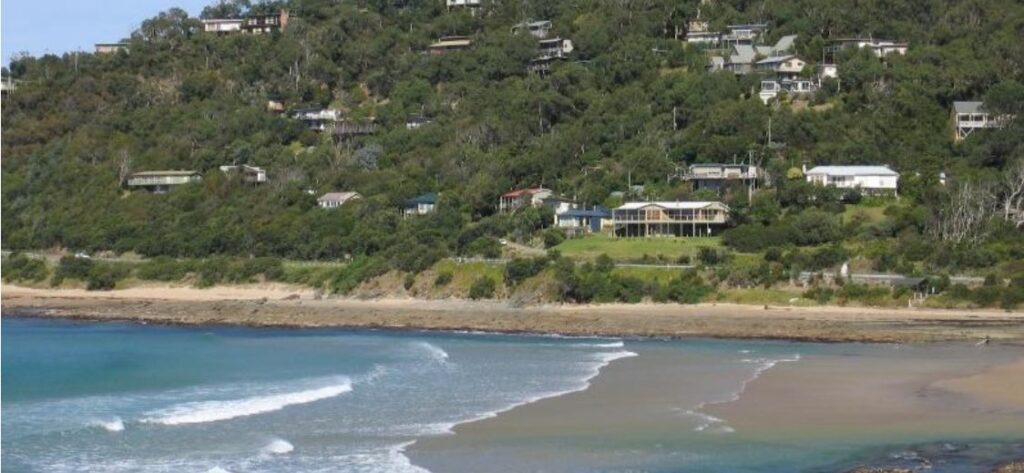
Going back almost 20 years, Wye River Fire Brigade identified that many of the new houses being built had CFA-dedicated water tanks that were unusable.
The tanks were either too far away from tanker access, the pipes connecting the tank to the outlet were too small, or in some cases the tanks were empty.
The 2015 Christmas Day fire demonstrated the importance of a dedicated 10,000-litre supply for defending properties. In a small town with no mains water, it can take up to 20 minutes for a tanker to refill at the station.
But many people, including plumbers, aren’t sure of the regulations and conditions that must be met when installing a CFA-dedicated water supply.
Wye River brigade’s Community Safety Coordinator Ian ‘Wellsy’ Wells set about finding out all the regulations that had to be met with a new build. The ‘Bushfire planning’ section of the Victoria Planning Provisions outlines the requirements, as well as CFA’s Guidelines for Remote Outlets on Water Tanks in the Bushfire Management Overlay.
“It really is quite complex when you dig down into it,” Wellsy said, “and in some cases it appears like it falls through the cracks in the whole building process.”
For example, regulations stipulate that a CFA truck must be able to access within four metres of an outlet. However, if the tank itself is more than four metres below the draughting point on the truck it can be difficult to both prime and maintain adequate flow rates.
“CFA’s guidelines only allow for gravity feed tanks, which is just not possible in hilly terrain where half the houses are on the down slope and road easements don’t allow for tanks to be at road level,” Wellsy said.
Wye River brigade has compiled a compliance audit sheet for each property so that it can inform the council of any issues. The audit sheet includes regulatory conditions and points from CFA’s guidelines, and is divided into sections covering signage, the outlet and pipework, and the size and position of the tank.
Wye River brigade discovered that building surveyors are not required to check compliance on CFA-dedicated tanks. Council compliance officers have the power to enforce these conditions, but only do so if they have been notified.
District 6 Assistant Chief Fire Officer Craig Brittain took this compliance issue to Colac Otway Municipal Emergency Management Planning Committee and it has now been referred to Barwon South West Regional Emergency Management Planning Committee and Municipal Association of Victoria.
New resident and CFA CEO Natalie MacDonald volunteered her house as a test case for the audit. Brigade members helped to determine the best location for the CFA tank and outlet. Following these discussions, Natalie decided to increase tank capacity to 15,000 litres. The house sprinkler system runs off a separate tank, allowing the brigade to have full use of the 15,000 litres. However, homeowners can always access a CFA tank if needed.
“We know residents often spend a lot of money installing a CFA-dedicated tank. We want to make sure they are safe for the brigade to access and are usable,” Wellsy said.
With the help of CFA’s Community Safety team, the brigade recently produced a flyer for residents (pictured below) that highlights the importance of CFA-dedicated water tanks and what owners can do, including maintaining good signage, clearing vegetation from around the outlet and ensuring tanks remain full.
Wye River brigade has also started mapping usable CFA-dedicated points on Google Maps for the township, as well as neighbouring Separation Creek, Kennett River and Grey River, which helps crews in pre-planning en route to a fire. The mapping also includes relevant information such as the presence of bunkers, solar panels and whether a house may contain asbestos.
We have great support from our community. We know they want to do all they can to keep the township safe from fire. They just needed to know ‘Wye?’
September 22nd, 2023Time to prepare your property for fire season CFA warns
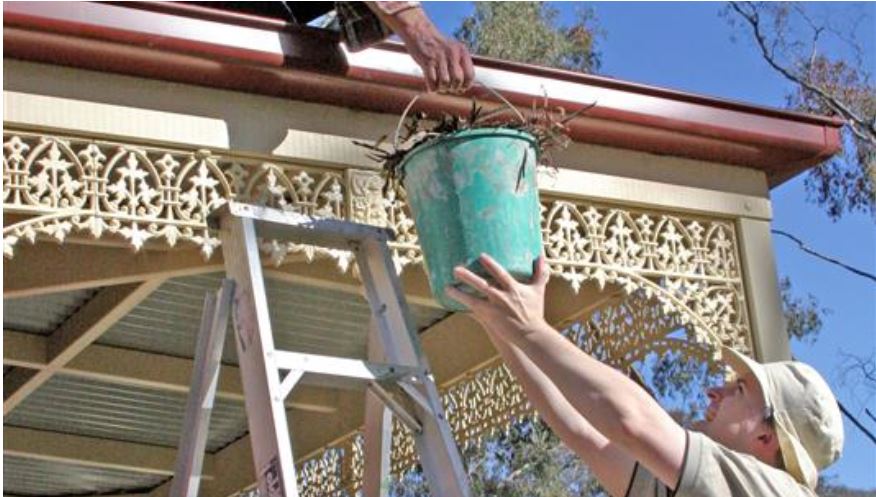
As Victoria’s weather begins to warm and we edge closer to an earlier fire season, the CFA’s message to those in high-risk bushfire areas is clear – prepare your property.
Victoria can expect a warmer spring, contributing to higher fire risk in parts of the state this season, according to the latest Spring Seasonal Outlook.
There are a number of simple tasks people can complete to reduce their risk this season, and now is the time to start taking action.
CFA Chief Officer Jason Heffernan said CFA crews right across the state are making every effort to prepare for this year’s fire season, but they need a collective community effort to reduce bushfire risk.
“Victoria is one of the most bushfire-prone areas in the world, so it’s vital for everyone to plan ahead,” he said.
“All it takes is some basic maintenance such as clearing your gutters, picking up loose leaves and twigs, pruning tree branches so they aren’t overhanging the roof of your property, or even just keeping your lawn under 10cm tall.
“High rainfall and moisture levels over the past 12 months will have led to vegetation growth on private properties, so it’s important to maintain your property through spring and into fire season.”
Chief Officer Heffernan also encouraged everyone to sit down with their family or household to discuss and practise their bushfire survival plan together.
“CFA has all the information you need on our website to create a clear bushfire plan with your loved ones,” he said.
“If you already have one, blow the dust off it and go over it with your family. Practising your bushfire survival plan could save your family’s life.”
Victorians can learn more about how to prepare their property at www.cfa.vic.gov.au/prepare, and for more about bushfire survival plan, visit www.cfa.vic.gov.au/bushfireplan.
Take the following actions to prepare yourself and your property:
- Move your winter woodpile away from the house or sheds.
- Prune tree branches so they are not overhanging the roof or touching walls.
- Clear your gutters.
- Keep grass shorter than 10cm.
- Remove leaves and twigs from around your property.
- Test anything that is part of your fire plan such as sprinklers, pumps and generators.
- The quickest and easiest way to register your burn-off is by using the Fire Permits Victoria website at www.firepermits.vic.gov.au/notify, or call ESTA on 1800 688 511.
- Make sure your household has a Bushfire Survival Plan. Find out how at www.cfa.vic.gov.au/bushfireplan.
September 18th, 2023Brigade smoke alarm drive
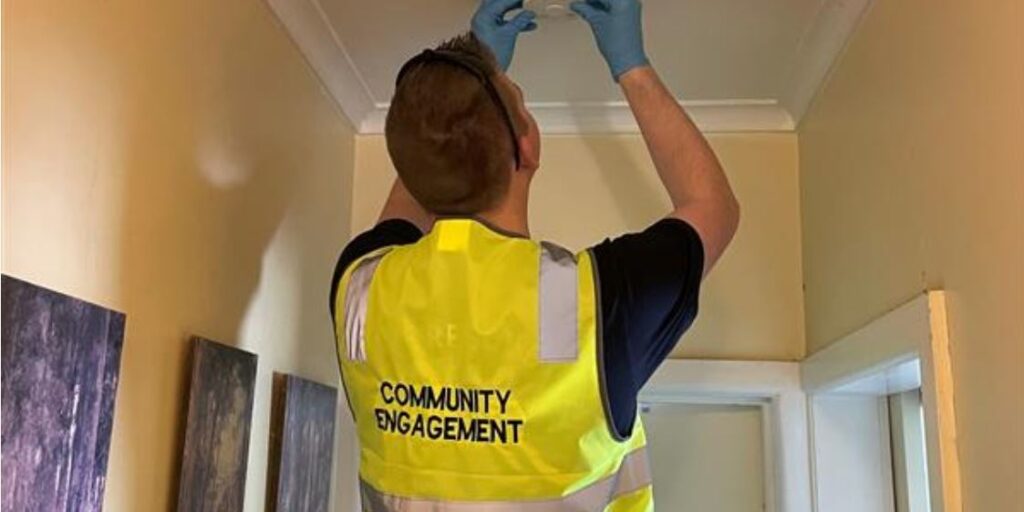
An ageing population has driven a local CFA brigade to install smoke alarms into more than 50 homes this month in an effort to keep the community safe.
CFA’s Yallourn North Fire Brigade identified a high number of homes with no smoke alarms or alarms that weren’t placed in the most effective areas of the house, such as bedrooms.
To address this safety issue, the brigade is running a two-day campaign on September 9 and 16 to install free 10-year lithium smoke alarms in homes locally. This is part of CFA’s Smoke Alarm Installation Program which is a vital initiative aimed at enhancing residential fire safety.
Yallourn North Brigade Captain Hayley King said the local area is made up properties with an average age of 60-80 years old and they might not be aware of the risk associated with not having a working smoke alarm.
“In previous years the brigade has organised a 9V battery giveaway, but this is the first time the brigade is actively installing smoke alarms,” Hayley said.
“The high number of uptake locally is due to the fact many residents were previously unaware of the associated fire risks and the added protection that smoke alarms in sleeping areas can provide.
“This initiative is specifically aimed at residents who are unable to install, test, or maintain their own alarms.”
Yallourn North has around 600 houses in total and the program and installations are completely volunteer driven.
More than 50 houses have signed up for the free smoke alarm installation so far and the brigade welcome more registrations for the 16 September.
September 13th, 2023New renewable energy guidelines out for firies

The latest CFA Design Guidelines and Model Requirements for Renewable Energy Facilities have been released.
CFA’s guideline provides fire risk management and emergency planning guidance and support for planners, designers and operators of wind energy facilities, large-scale solar and battery energy storage facilities in the country area of Victoria.
CFA’s guideline complements existing Victorian government guidance for renewable energy facilities.
It details CFA’s minimum expectations for fire risk management in planning, design and operation specific to facility siting, emergency access, water supply, vegetation management and emergency planning.
CFA’s guideline is underpinned by the operational knowledge gained from fires at large-scale renewable energy facilities, engaging with leading national and international researchers and industry, and CFA’s unique experience in assessing and advising on fire risk management for hundreds of renewable energy developments across the country area of Victoria.
The latest, Version 4 of CFA’s guideline includes:
- Updated guidance for decentralised arrangements of battery energy storage systems.
- Additional guidance on fire risk management and emergency planning for battery energy storage systems in commercial and industrial applications and community/neighbourhood batteries.
- Expanded guidance on emergency response considerations for large-scale battery energy storage systems.
- A checklist to support application of the guideline.
CFA leads the sector in fire risk management guidance for renewable energy facilities.
CFA’s updated guideline reflects the latest strategies for incident response as changes in technology, increases in energy density and evolving facility designs pose challenges for responding emergency services.
To see the updated guidelines, visit https://www.cfa.vic.gov.au/plan-prepare/building-planning-regulations/renewable-energy-fire-safety.
Please contact CFA’s Specialist Risk and Fire Safety Unit at risk-info@cfa.vic.gov.au for any information regarding the CFA guidelines or fire risk management at renewable energy facilities and proposed developments.
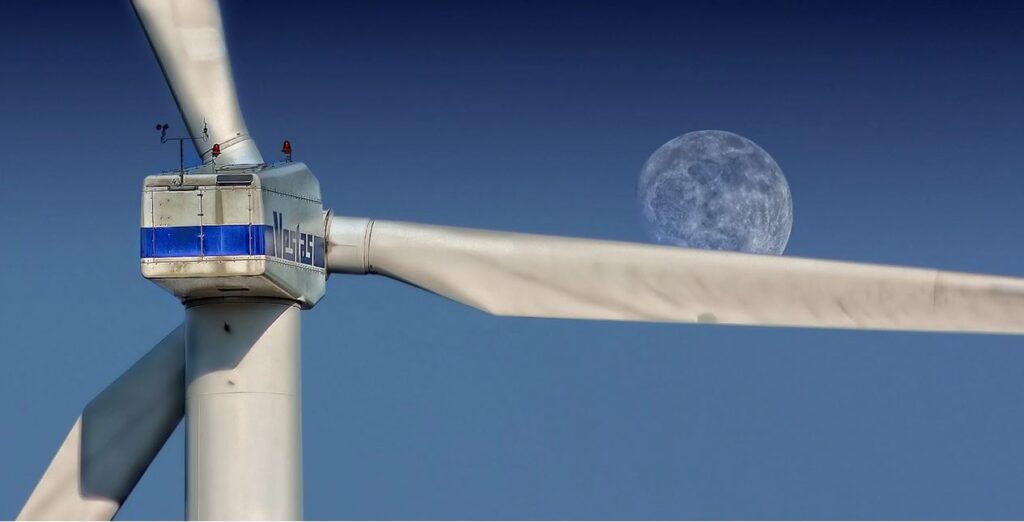
September 12th, 2023Firies reach new heights for mental health
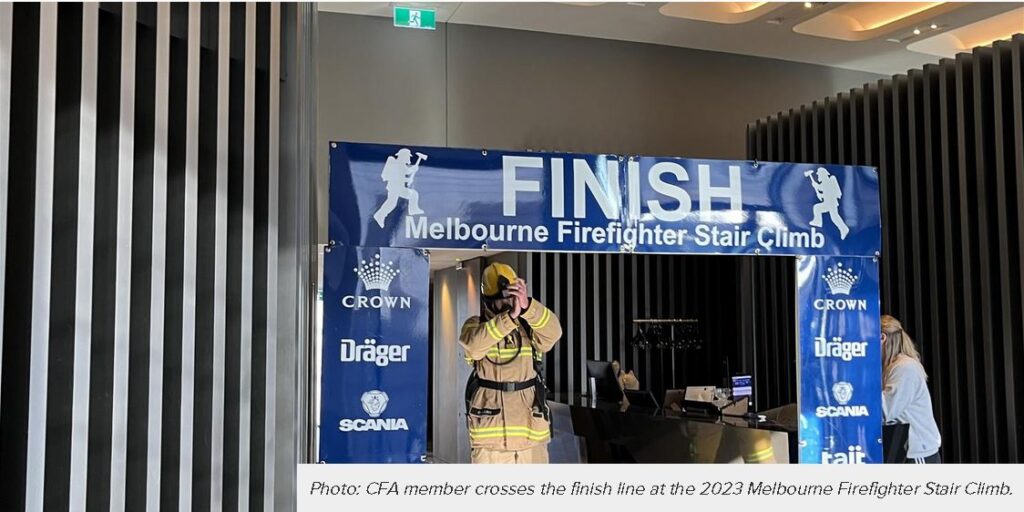
Up to 700 participating Victorian and interstate emergency services members climbed the stairs of Crown Metropol in Melbourne earlier this month, to raise money and awareness for mental health and cancer research.
The 10th annual Melbourne Firefighter Stair Climb, organised by the 000Foundation took place on September 2 and raised a total of more than $605,000.
This year’s beneficiaries are Lifeline, Peter MacCallum Cancer Foundation and 000Foundation.
The challenge saw firefighters get into 25kg of protective gear and race up 28 floors of the tower one-by-one.
CFA Deputy Chief Officer Garry Cook said it’s positive to see emergency services personnel come together in person to support such a worthwhile cause.
“Our members are enthusiastic participants of this event and it’s great to see their contributions make a difference by raising money and awareness for mental health programs and cancer research,” he said.
Firefighters and emergency personnel from all over Australia flocked to Melbourne to be part of the stair climb.
CFA firefighters climbed alongside members from FRV, FFMVic, Victoria Police, VICSES, Ambulance Victoria and members from Tasmania, New South Wales, South Australia and New Zealand.
Since the Melbourne Firefighter Stair Climb Challenge began in 2014, the event has raised more than $3.5 million, benefitting charities and organisations such as Alfred Hospital Burns Unit, Peter MacCallum Cancer Centre, Murdoch Children’s Research Institute, Lifeline, Black Dog Institute, Emergency Services Foundation and 000Foundation.
September 12th, 2023CFA saves 3000 lives during blood challenge
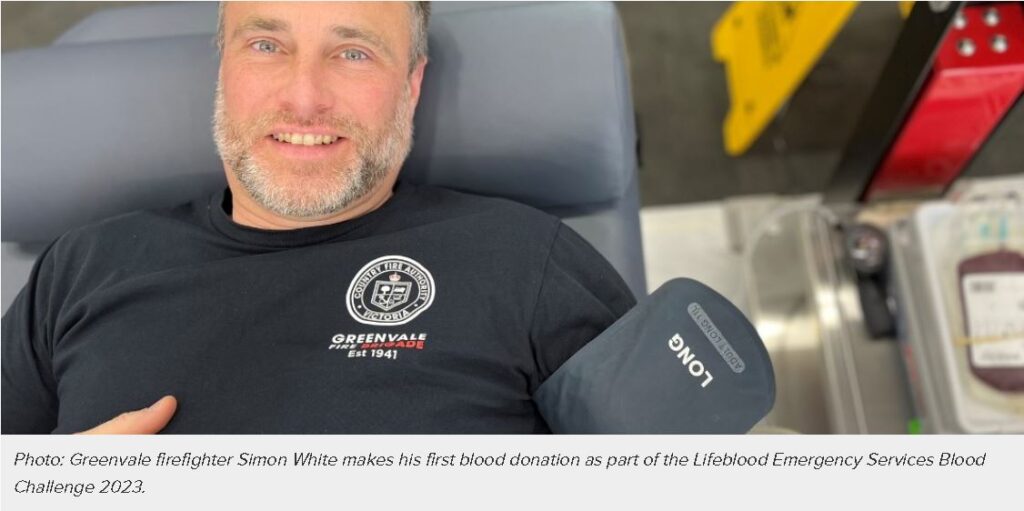
The CFA proudly achieved third place overall in this year’s Emergency Services Blood Challenge, behind NSW and Victoria Police.
Team CFA saved around 3000 lives by making more than 1000 donations.
The overall contribution by CFA members included around 600 plasma, 390 whole blood and 15 platelet donations between 1 June to 31 August.
The drive encouraged emergency service members to make a significant contribution to those in need by donating blood and plasma.
Greenvale firefighter Simon White made his first-ever blood donation during this year’s challenge.
“I’ve been wanting to do it for a while and being from the UK during the outbreak of mad cow disease prevented me for many years,” he said.
“This year, they lifted the restriction and I was excited to help out.
“If you’ve got an opportunity to help someone else, such as donating blood, then for me it’s a no-brainer.”
CFA Chief Officer Jason Heffernan, who personally made a donation this year, said members should be proud of the contribution they’ve made and the positive impact it’s had on those in need of blood.
“Our members really get behind initiatives that benefit the community and this is no exception,” he said.
“While the blood drive has concluded this year, I hope many of our members can keep up these good habits and continue donating blood, if they can.”
For more information about the Emergency Services Blood Challenge and how to make a blood donation yourself, visit the Lifeblood website at www.lifeblood.com.au.
September 11th, 2023CFA service runs in the family
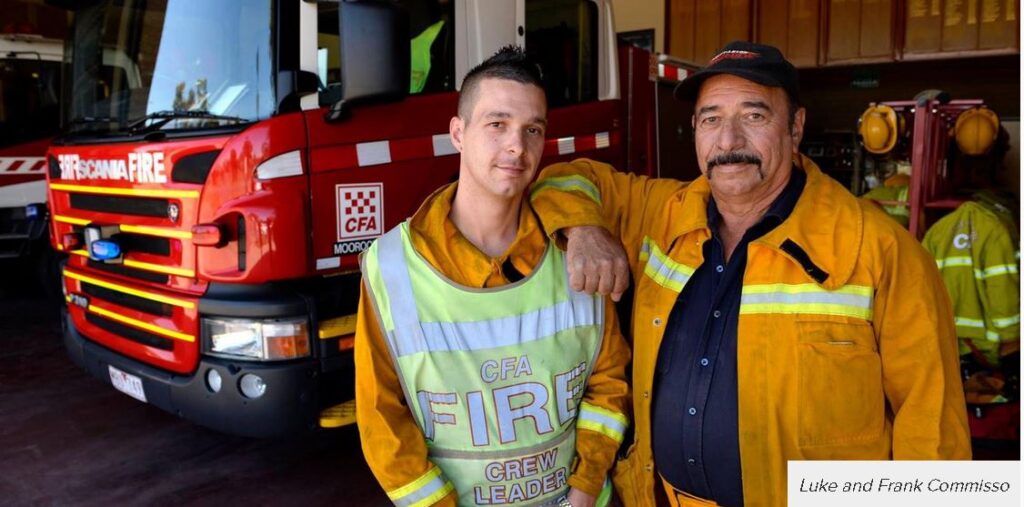
Frank and Luke Commisso are just one of the many wonderful family pairs within CFA.
The father and son, Frank, 72, and Luke, 38, are 1st Lieutenant and Captain, respectively, of North West Mooroopna Fire Brigade.
Inspired by Frank’s brother Mario to join, the pair have been on more than 100 strike teams between them in their 20-year span, including the 2009 fires, the Hazelwood coal mine fire and the 2022 floods, which heavily impacted their local area.
Luke recounts a funny moment from his time on a strike team to the Hazelwood fire.
“We’re known to squabble a little bit here and there, being father and son,” Luke said.
“I was about to step on the bus and the bus driver stood up, stepped in front of the door, looked at us and said, ‘any squabbling, any jokes, anything from you two and you’re off the bus’, and everyone just laughed because they know exactly what we’re like.”
Frank said both him and Luke like to keep morale up on strike teams – situations they acknowledge can often be quite difficult.
“If morale is up, you’ve got good firefighting – so that’s really important to both Luke and me,” Frank said.
Luke said that his favourite part about volunteering with his dad was having someone to support him at all times.
“I think just knowing that I’ve got good support beside me, it’s good knowing that I’ve got him by my side,” Luke said.
Frank echoed Luke’s statement.
“We know each other’s strengths and we know what the other one is capable of, which helps us on the fireground,” Frank said.
Both Frank and Luke say the best part of volunteering as a whole is knowing that, at the end of the day, you’ve helped someone.
“It’s a great feeling, giving back and knowing you’ve helped someone – and it encourages you to keep going and get out there and do more. It gives you that motivation to keep going,” Luke said.
“As well as that, the leadership skills I’ve developed through the CFA are absolutely incredible.”
September 10th, 2023Cardiac arrest survivor’s tearful reunion with life-savers

A father who suffered a cardiac arrest while driving home from work a few months ago has in recent days reunited with the emergency services responders who saved his life.
On 18 June, Bryde McNamara was only a few hundred metres away from his home when he suffered a cardiac arrest and veered off the road, down a three-metre embankment and into a building at Healesville High School.
His family heard the crash and rushed to help, with his son Kayden calling Triple Zero (000).
Bryde’s wife Jess and a bystander started CPR before paramedics arrived on scene.
Healesville Fire Brigade volunteer Graeme Bates said the CFA crew arrived on scene shortly after Ambulance Victoria and they assisted paramedics with CPR and the medical response.
“The school oval was a great resource for the Ambulance Victoria helicopters. They were delivering blood and I was assisting pumping the blood into Bryde,” Graeme said.
“SES and CFA worked together to secure the wall of the building so the bricks wouldn’t collapse.
“There was a lot happening and it was a great multi-agency effort.
“It’s rare for someone in this situation to survive so he was lucky to have age on his side and a quick response by family and emergency services.”
Bryde and his family met with his first responders last Sunday on Father’s Day which was an emotional reunion. The whole family expressed their heartfelt gratitude.






